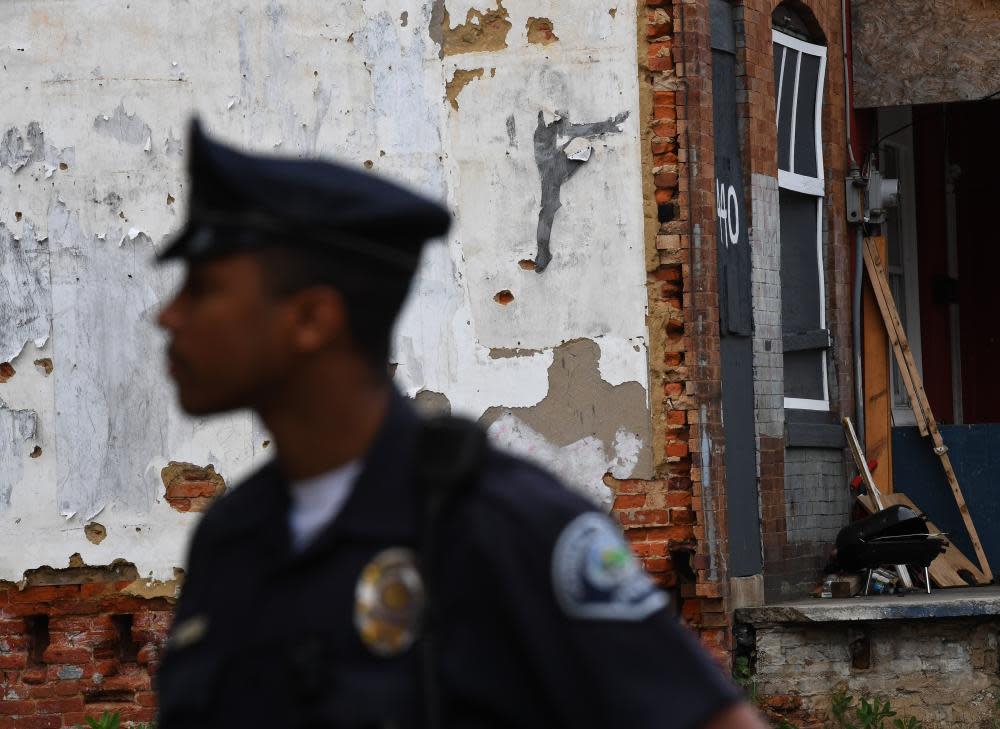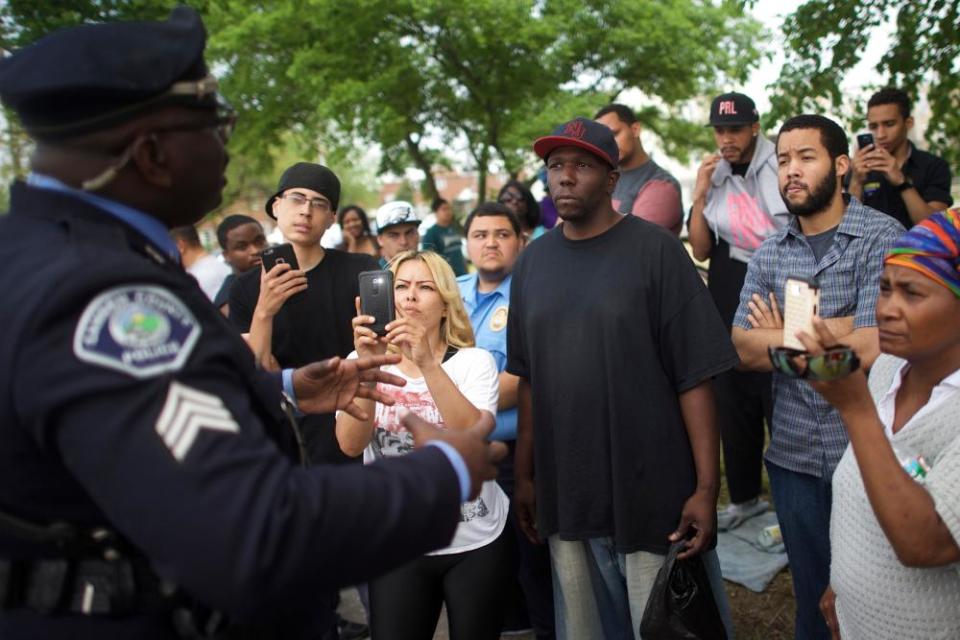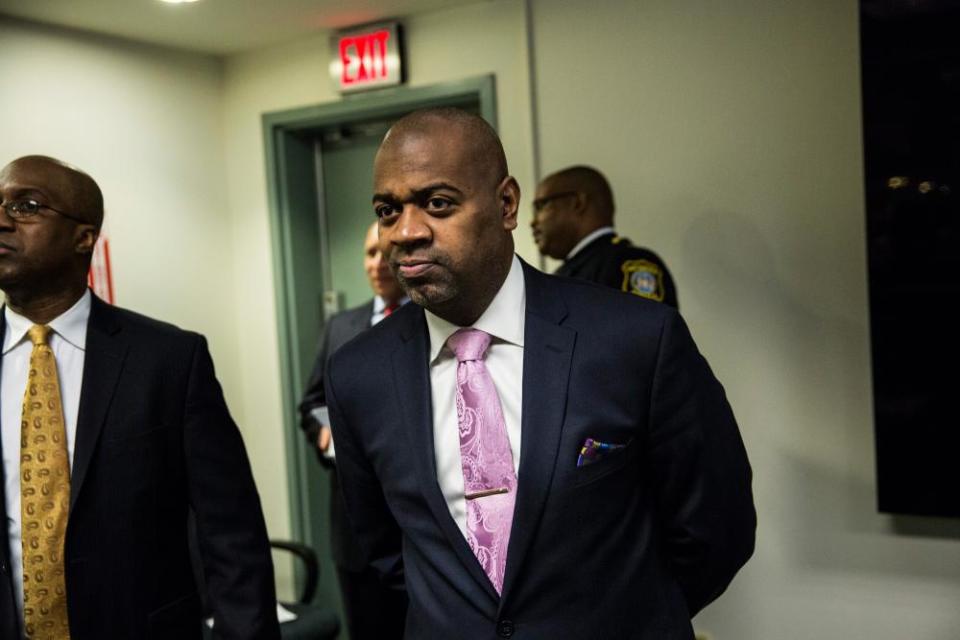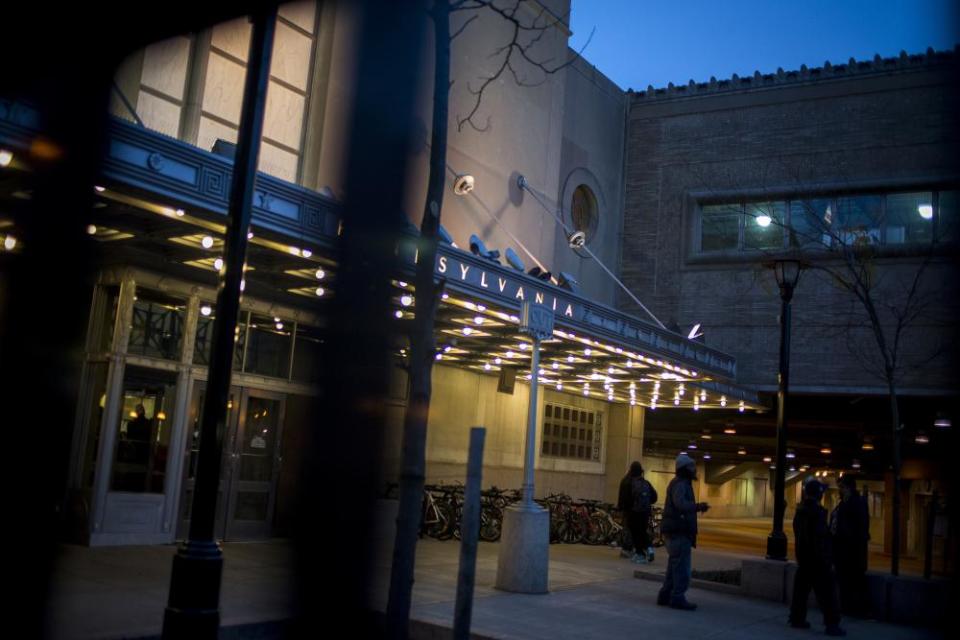These New Jersey cities reformed their police – what happened next?

Four years ago Aqeela Sherrills set up shop in the worn carriage house of the old fifth police precinct, a red brick building in Newark, New Jersey. The city’s newly elected mayor had called on him to fight crime and gun deaths with community interventions, instead of police.
For Newark, a majority Black city with a reputation of violence, poverty and a long history of police brutality against its residents, it was a somewhat radical new move.
Related: Rethinking the police: what can the US learn from Newark? – podcast
But Sherrills was hardly intimidated. He grew up in the Watts neighborhood of Los Angeles and had helped broker a peace treaty between the Crips and the Bloods, two of the largest and most infamous gangs in the city. Like countless parents in his community, gun violence had hit his own home: his son, Terrell, was murdered in 2005 at a party.
“I’ve been doing this work for 16 years – on the frontlines, and in the trenches,” Sherrils said, sitting at a desk at the Newark Street Team headquarters in mid-June.
Across America, protests against police brutality have been erupting for weeks after the death of George Floyd, with footage of new police killings of unarmed Black men resurfacing weekly. Amid that movement, many are grasping for meaningful solutions to the phenomenon that kills an average of a thousand people every year, a quarter of them Black.
Camden and Newark, two cities in New Jersey, are among those that have been held up as powerful examples of positive change. The two cities have seen structural reforms to their police departments and a steep drop in crime, both within the communities and inflicted by the police.
We need to present at the table – this is no longer a slave plantation
Dr Doris Carpenter
But for the people living in these cities, the trauma of violence is still palpable and brutality incidents are still a reality. The statistics touted as success can feel like an insult as families struggle to survive.
“When I heard that we were a model city, I almost fell off my chair,” said Dr Doris Carpenter, who grew up in Camden and attended a protest this month. “Until people rise, Camden won’t rise, and so often [city officials are] making decisions for us. We need to present at the table – this is no longer a slave plantation.”
The reform
Camden and Newark have had two distinct approaches to changing their police systems.
In 2013, Camden disbanded its city police at the behest of state and local lawmakers. At the time, there were about 200 police officers, according to the county spokesperson, but 30 percent would call out absent on any given day. That year, however, then governor Chris Christie slashed aid to the city by 20%.
In response, city officials came together to enact a new plan: disband the city police, including the expensive police union contract, and rehire more police under the local county jurisdiction of the same name.
In 2016, Camden county also teamed up with New York University’s Policing Project, which acted as a consultant to help update the police department’s policies, including the use of force, which determines what a police officer is allowed to do when interacting with a resident. The county implemented trainings, anti-bias programs and simulators, following American Civil Liberties Union of New Jersey guidelines.
“It’s really important to have clear policies so that if an officer breaks the rules down the road you can hold them accountable,” said Farhang Heydari, a director at the Policing Project who has worked with the city.
The result: a different kind of police force.

Currently, the Camden police budget is $69m, up from $62m in 2013. And the number of police has gone up from 200 to 380 people. The crime rate is at a 50-year low, and excessive force complaints (which are reported from the police department itself) have dropped from 64 to three in two years, according to a country spokesperson.
There has also been a crucial shift in police leadership. Even the most vocal critics in Camden said the county police chief, Joe Wysocki, who took over last year, is the most transparent and fair leader they have seen in the city. Activists shook his hand and made small talk when the chief arrived at a recent protest in the city, wearing a pair of shorts and a polo shirt because he was on vacation.
In Newark, meanwhile, there was no specific or sweeping restructuring. Instead, changes started to accelerate when the mayor, Ras Baraka, was elected in 2014, and only after decades of community organizing between clergy, city officials and activists on the issue.
The son of a radical poet, Baraka himself was an activist who protested police brutality and the impact it had on his family. When he took office he quickly started to implement changes.
The Obama administration had initiated a consent decree – an agreement between the city and Department of Justice – that defined community policing, and specific actions that needed to be taken in the department in 2014. Baraka took these forward when he was elected, and supported other, complementary initiatives, such as Sherrill’s Newark Street Team.

Under Baraka, Newark also established a citizen review board to independently investigate incidents of police abuse. In response, the police union sued the city in state supreme court, where the case has yet to be resolved.
“We don’t have a contentious relationship,” Baraka said of the police department. “But the police unions are mostly populated by retired officers” who don’t want to dilute the power of law enforcement.
This month, as activists across the country called on cities to “defund the police”, Baraka moved 5% from the police budget ($235m last year) to other anti-violence initiatives and plans to turn a police precinct into a museum.
Opposition on the ground
If there’s an overlap between Newark and Camden’s approach to police reform, it’s that each city’s people still feel there are gaping holes in public safety.
In Camden, boarded up buildings line the city outskirts, and family incomes trail behind the rest of the state at just $26,000 a year. People tell stories: officers busting into a home and physically carrying out a man because he hadn’t paid child support. Police officers pepper spraying young men for trespassing. Police cars with bright lights flashing through the night while residents try to sleep. Police officers are not representative of the city, where about three-quarters of the residents identify as minorities, and live out of the county limits, away from the neighborhoods they patrol.
We don’t have a relationship with the police here
Porta Rich
Porta Rich, a 40-year-old musician and Camden native, said people in the city don’t know the police. He recalled an incident where he was walking to a store at night and the police asked for his information and pulled a gun on him, even though all he had was a pocket knife tucked away.
“They want to tell CNN and all these big places that the city is rising, the police force is perfect and it’s a bunch of bullshit,” he said, standing outside a historic site at a protest in Camden last week. “We don’t have a relationship with the police here.”
Other residents say Camden is following the controversial “broken windows” system, where police respond to small-scale crimes to show force.
“This city has been through so much stress and trauma – in so many ways it’s a broken city with broken people,” said Ojii Baba Madi, a minister at nearby Asbury community church and Camden native. “So if you’re police you gotta be effective. Are you trained on these issues? I don’t need a police officer coming here harassing a young person for smoking a cigarette.”
In Newark, more than a quarter of the city’s population lives under the poverty line, and many of them in the south and west wards. A group led by Larry Hamm, a longtime activist and candidate for Senate, has held Justice Mondays every week to protest police brutality at city hall since 2016. Residents shout out new names each time, adding to a long list of friends and family who have died at the hands of law enforcement.
“They’re not just a paramilitary force, they’re a political force,” Hamm said. “The police are a very powerful institution, and power corrupts.”
Daamin Durden, a native of the city and part of Sherrill’s street team, said though there have been improvements, law enforcement still doesn’t reflect the community. Just last year, a Newark police officer killed a man during a traffic violation, and this year there have been 16 use of force complaints so far, according to a spokesperson for the police department.
Meanwhile Durden recently mediated an argument between two men in his neighborhood that was poised to become violent because they both had children from the same mother.
“Eventually, [the man] knew he couldn’t look at his child in the face if he killed the other man,” he said. Police, meanwhile, don’t always understand these dynamics, he said. As he was speaking, Durden’s phone alerted him to another shooting nearby.

How do you track progress?
As the country grapples with addressing police brutality against Black victims, the cities held up as examples are still grappling to define and substantiate their own success.
While crime has dropped in Newark and Camden, some say that’s simply a reflection of a national trend – US crime has dropped more than 50% since the early 1990s – and not specific to police reform. Others question the use of force data reported often from within the departments themselves.
“We are angling the numbers to make it look like this is a model city, but I would not want any city to go through what we went through with the change,” said Carpenter in Camden.
But Camden county spokesperson Dan Keashen pointed out that Camden’s crime rate dropped specifically after 2012, when the police was disbanded, and that the excessive force complaints in Camden are reviewed by the attorney general. He cited metrics like lower gunshot wounds, documented cases of police deescalating violent incidents and anecdotes of city residents as some metrics of success.
“Productivity is measured in outcomes,” he said. “So if Mrs Smith is now able to patronize her local bodega or corner store to get a quart of milk without fear of having to pass an open air drug market … because of the presence of one of our officers, then we consider that extremely effective police work.”
For Hadari, who works to research and implement police reform at NYU, it remains difficult to quantify a city’s success. “You’re seeing departments take into account more than crime rates, because that’s a cycle that feeds on itself – if you send officers to places where there’s more crime, they observe more crime.” But that doesn’t mean that progress isn’t being made.
Sherrills said the progress in Newark could not be wholly attributed to police reform when so many other forces are in play, including his team, who operate in schools, hospitals and neighborhoods, always unarmed. His similar program in Los Angeles was linked to a significant decrease in violent retaliation incidents, and juvenile crime.
They’ve done all this study and research nationally, and haven’t been able to put a huge dent in the problem
Aqeela Sherrills
“They’ve done all this study and research nationally, and haven’t been able to put a huge dent in the problem,” Sherrills said of police reform efforts. “It’s because they’re building systems above the problem. Our whole thing is, hey, we’re going to address the root cause.”
Brian O’Hara, a police captain in the Newark Police Department who oversees enforcement of the consent decree, said that it was a combination of community and police that had made the city safer. “There’s no question that the Newark community street team does an amazing job and that their work has without question, saved lives,” he said.
“So, you know, obviously, if there are fewer murders in the city of Newark, that’s helping the police, you know, and it’s helping everybody involved.”
At recent protests in Camden and Newark, each city’s different approach to police reform was on display.

In Camden, police lined the street on the protest route in cars and on bikes, usually at a distance. Later, a protest organizer called Black police officers up to a stone platform where protesters and the city had dismantled a statue of Christopher Columbus.
The police lifted their fists in agreement with the message. Wysocki stood nearby.
Meanwhile, in Newark, as Hamm and a few dozen protesters chanted and called out names of victims in front of city hall. Uniforms were nowhere to be seen, but later I found out that three plain-clothed police officers stood in the vicinity.
For residents in both cities, the spotlight on the police through protests was welcome. Not because they wholeheartedly agreed with how the forces had changed, but because most residents had spent years attempting to withstand the trauma and violence of their everyday lives without anyone listening.
This moment revealed the possibility of change. “I don’t want to replicate [this] in other cities,” said Madi, who has buried many young people killed by gun violence as a minister. “I want a conversation. I want to understand the psychological condition of this city.”

